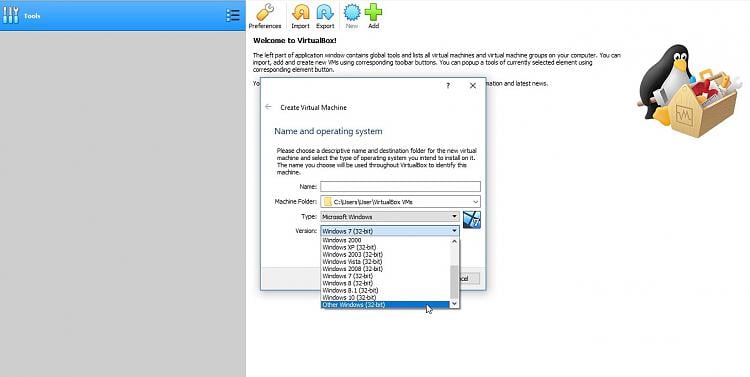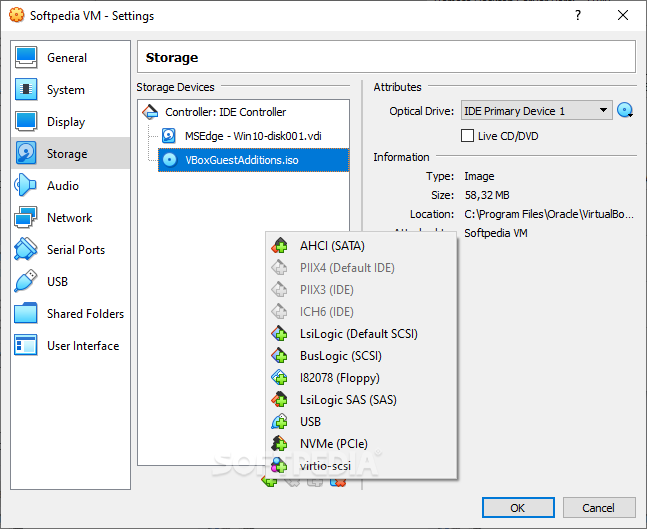Attempting to start 32 bit XP Virtual Box VM hangs the Linux server! User596857 Member Posts: 134 Feb 11, 2012 8:35PM edited Feb 12, 2012 4:03PM in Oracle VM Server for x86.
VirtualBox is a general-purpose full virtualizer for x86 hardware, targeted at server, desktop and embedded use.For a thorough introduction to virtualization and VirtualBox. Virtualbox 32 Bit - downyup. VirtualBox for Windows 7 - original software that allows you to experiment with operating systems. Creates a virtual machine, allows you to set iron parameters within certain limits. The advantage is the modular architecture and the presence of internal logic. Suitable for users with an average level of skills. Virtualbox 32bit free download - Adobe Captivate (32-bit), 32bit FTP, WinRAR (32-bit), and many more programs. Initializing Installation with Oracle VM VirtualBox Manager. Open the Oracle VM VirtualBox manager, click on new, and type in the name of the new operating system you want to create; in this case, it is Arch Linux. The system will automatically pick up the type and version of the Arch Linux, based on your system’s configuration.
It is possible to run Tails in a virtual machine using VirtualBox from aWindows, Linux, or macOS host operating system.
VirtualBox has a free software version,called VirtualBox Open Source Editionand some proprietary components, for example to add support for USBdevices.
With the shared folders feature ofVirtualBox you can access files of yourhost system from within the guest system.

Make sure to understand the security implications of accessinginternal hard disksfrom Tails before using this feature.
In our security warnings aboutvirtualization we recommend to run Tails ina virtual machine only if the host operating system is trustworthy.
To install VirtualBox in Debian or Ubuntu, execute the followingcommand:
For instructions on how to install VirtualBox on other operatingsystems, refer to the VirtualBox documentation.

First, start VirtualBox.
To create a new virtual machine:
- Choose Machine ▸ New....
- In the Name and operating system screen, specify:
- A name of your choice.
- Type: Linux.
- Version: Other Linux (64 bit).
- Click Next.
- In the Memory size screen:
- Allocate at least 2048 MB of RAM.
- Click Next.
- In the Hard drive screen:
- Choose Do not add a virtual hard drive.
- Click Create.
- Click Continue in the warning dialog about creating a virtualmachine without a hard drive.
To configure the virtual machine to start from an ISO image:
- Select the new virtual machine in the left pane.
- Choose Machine ▸ Settings....
- Select System in the left pane.
- In the Extended Features section of the Motherboard tab, make sure that Enable I/O APIC is enabled.
- Select Storage in the left pane.
- Select Empty below Contoller IDE in the Storage Tree selection list in the right pane.
- Click on the CD icon on the right of the window and selectChoose a virtual CD/DVD disk file... to browse for the ISO imageyou want to start Tails from.
- Check the Live CD/DVD option.
- Click OK.
Kali Linux
To start the new virtual machine:
- Select the virtual machine in the left pane.
- Click Start.
Because Oracle VM VirtualBox is designed to provide a generic virtualization environment for x86 systems, it can run operating systems (OSes) of any kind. However, Oracle VM VirtualBox focuses on the following guest systems:
Windows NT 4.0:
Fully supports all versions, editions, and service packs. Note that you might encounter issues with some older service packs, so install at least service pack 6a.
Guest Additions are available with a limited feature set.
Windows 2000, Windows XP, Windows Server 2003, Windows Vista, Windows Server 2008, Windows 7, Windows Server 2008 R2, Windows 8, Windows Server 2012, Windows 8.1, Windows Server 2012 R2, Windows 10 (non-Insider Preview releases), Windows Server 2016, Windows Server 2019:
Fully supports all versions, editions, and service packs, including 64-bit versions.
Note that you must enable hardware virtualization when running at least Windows 8.
Guest Additions are available.
MS-DOS, Windows 3.x, Windows 95, Windows 98, Windows ME:
Limited testing has been performed.
Use beyond legacy installation mechanisms is not recommended.
Guest Additions are not available.
Linux 2.4:
Limited support.
Linux 2.6:
Fully supports all versions and editions, both 32-bit and 64-bit.
For best performance, use at least Linux kernel version 2.6.13.
Guest Additions are available.
Certain Linux kernel releases have bugs that prevent them from executing in a virtual environment. See Buggy Linux 2.6 Kernel Versions.
Linux 3.x and later:
Fully supports all versions and editions, both 32-bit and 64-bit.
Guest Additions are available.
Oracle Solaris 10 and Oracle Solaris 11:
Fully supports all versions starting with Oracle Solaris 10 8/08 and Oracle Solaris 11.
Supports 64-bit prior to Oracle Solaris 11 11/11, and 32-bit.
Guest Additions are available.
FreeBSD:
Limited support.
Note that you must enable hardware virtualization when running FreeBSD.
Guest Additions are not available.
OpenBSD:
Supports at least version 3.7.
Note that you must enable hardware virtualization when running OpenBSD.
Guest Additions are not available.
OS/2 Warp 4.5:
Only MCP2 is supported. Other OS/2 versions might not work.
Note that you must enable hardware virtualization when running OS/2 Warp 4.5.
Guest Additions are available with a limited feature set. See Known Limitations.
Mac OS X:
Oracle VM VirtualBox 3.2 added experimental support for Mac OS X guests, with restrictions. See Section 3.1.1, “Mac OS X Guests” and Known Limitations.
Guest Additions are not available.
Oracle VM VirtualBox enables you to install and execute unmodified versions of Mac OS X guests on supported host hardware. Note that this feature is experimental and thus unsupported.
Oracle VM VirtualBox is the first product to provide the modern PC architecture expected by OS X without requiring any of the modifications used by competing virtualization solutions. For example, some competing solutions perform modifications to the Mac OS X install DVDs, such as a different boot loader and replaced files.
Download Oracle Vm Virtualbox 32-bit
Be aware of the following important issues before you attempt to install a Mac OS X guest:
Mac OS X is commercial, licensed software and contains both license and technical restrictions that limit its use to certain hardware and usage scenarios. You must understand and comply with these restrictions.
In particular, Apple prohibits the installation of most versions of Mac OS X on non-Apple hardware.
These license restrictions are also enforced on a technical level. Mac OS X verifies that it is running on Apple hardware. Most DVDs that accompany Apple hardware check for the exact model. These restrictions are not circumvented by Oracle VM VirtualBox and continue to apply.
Only CPUs that are known and tested by Apple are supported. As a result, if your Intel CPU is newer than the Mac OS X build, or if you have a non-Intel CPU, you will likely encounter a panic during bootup with an 'Unsupported CPU' exception.
Ensure that you use the Mac OS X DVD that comes with your Apple hardware.
The Mac OS X installer expects the hard disk to be partitioned. So, the installer will not offer a partition selection to you. Before you can install the software successfully, start the Disk Utility from the Tools menu and partition the hard disk. Close the Disk Utility and proceed with the installation.
In addition, Mac OS X support in Oracle VM VirtualBox is an experimental feature. See Known Limitations.

Be sure to enable I/O APIC for virtual machines that you intend to use in 64-bit mode. This is especially true for 64-bit Windows VMs. See Section 3.4.2, “Advanced Tab”. For 64-bit Windows guests, ensure that the VM uses the Intel networking device because there is no 64-bit driver support for the AMD PCNet card. See Section 6.1, “Virtual Networking Hardware”.
If you use the Create VM wizard of the VirtualBox Manager, Oracle VM VirtualBox automatically uses the correct settings for each selected 64-bit OS type. See Section 1.7, “Creating Your First Virtual Machine”.
Copyright © 2004, 2020 Oracle and/or its affiliates. All rights reserved. Legal Notices
Comments are closed.